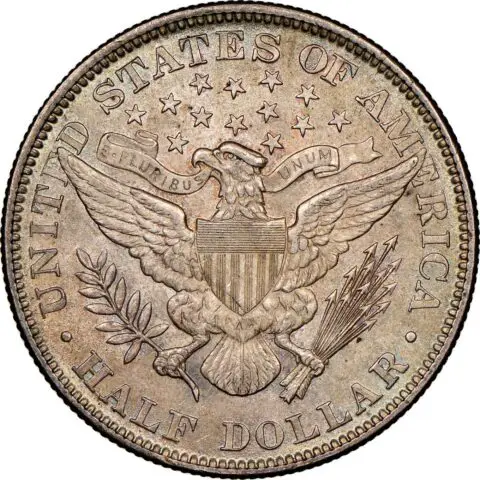
Thinking about some of the coins in my collection that are among my favorites, my mind quickly brings up the image of a Barber half dollar.
Barber half dollars are big old coins that saw heavy use during their 1892-1915 production. By the way, Barber half dollars are also commonly called Liberty Head half dollars.
Of all the regularly circulating Barber coins, which includes the Barber dime, Barber quarter, and Liberty nickel (each also designed by Charles E. Barber), Barber halves are perhaps among the most difficult series to complete in decent grades.
Collecting Barber Half Dollars
As mentioned earlier, Barber half dollars saw heavy circulation during their heyday.
Mainly for this reason (and collector demand), Barber half dollars of any date are becoming very difficult to locate in the higher circulated grades (Extremely Fine and above).
Barber half dollars in Fine and Very Fine are also relatively scarce in number when compared to the numbers of Barber half dollars that grade between Good and Very Good.
Amazingly, it can be a bit of a task to find certain dates of decent, uncleaned, undamaged Barber half dollars in even Good and Very Good grades.

Unfortunately, a large number of Barber half dollars show some evidence of cleaning, polishing, or artificial toning. Many Barber half dollars that are not cleaned seem to display too many signs of minor to moderate damage, like rim dings, nicks, scratches, and marks.
As a personal note, I can tell you that when I began collecting coins in the early- to mid-1990s, I remember seeing problem-free Barber half dollars grading Good to Very Good selling for between $5 and $8.
It seems prices have taken a major leap over the past few years, and it has gotten to the point that prices for common-date Barber half dollars in those same grades have more than doubled… even tripled!
However, no one can ever guarantee or predict if such price increases will continue or, for that matter, even be erased by price decreases. Yet, problem-free Barber half dollars are always popular with coin collectors.
The bottom line here? Nice, problem-free Barber half dollars are in demand. If you are in the market for nice Barber half dollars, be patient and shop around.
Then when you find a suitable candidate, you may not want to wait too long to buy it. There will always be other buyers who can recognize a nice Barber half dollar when they see it.
Scarce Barber Half Dollar Values
There are several dates in the Barber half dollar series which are considered scarce.
| Year | Mintage | Low Price | High Price |
|---|---|---|---|
| 1892-O | 390,000 | $350 | $1,800 |
| 1892-O Micro-O | Unknown | $5,800 | $52,500 |
| 1892-S | 1,029,028 | $265 | $2,000 |
| 1893-S | 740,000 | $165 | $4,000 |
| 1896-S | 1,140,948 | $110 | $3,500 |
| 1897-O | 632,000 | $170 | $3,800 |
| 1897-S | 933,900 | $160 | $3,500 |
| 1913 | 188,627 | $70 | $2,200 |
| 1914 | 124,610 | $160 | $2,500 |
| 1915 | 138,450 | $115 | $2,750 |
Common Barber Half Dollar Values
Dates not listed above can generally be considered common. Common Barber half dollars are generally priced between $20 to $35 for those grading Good-4.
Prices increase from there, based on the grade and date. Barber half dollars grading Fine (which is a major grading benchmark for Barber half dollars) cost at least $35 and up for decent pieces.
Thankfully, for the collector trying to assemble a complete collection of the coin, the Barber half dollar series consists mainly of common-date pieces. Common-date Barber half dollars are more or less uniformly priced, especially for coins grading Good-4 to Very Good-8.




